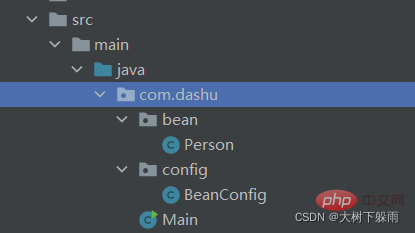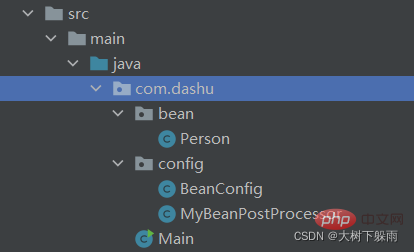Example analysis of Java Spring Bean life cycle management
Life cycle management of Spring Bean
1. Life cycle of Spring Bean

通过以下方式来指定Bean的初始化和销毁方法, 当Bean为单例时,Bean归Spring容器管理,Spring容器关闭,就会调用Bean的销毁方法 当Bean为多例时,Bean不归Spring容器管理,Spring容器关闭,不会调用Bean的销毁方法
2. Specify the initialization and destruction methods of the Bean through @Bean parameters (initMethod, destroyMethod)
1. Project structure

2. Person
public class Person {
public Person(){
System.out.println("Person 创建了...");
}
public void init(){
System.out.println("Person 初始化了...");
}
public void destroy(){
System.out.println("Person 被销毁了...");
}
}3. Bean registration configuration class (single instance)
import com.dashu.bean.Person;
import org.springframework.context.annotation.*;
@Configuration
public class BeanConfig {
@Bean(initMethod = "init",destroyMethod = "destroy")
public Person person(){
return new Person();
}
}4. Test class
import com.dashu.bean.Person;
import com.dashu.config.BeanConfig;
import org.springframework.context.annotation.AnnotationConfigApplicationContext;
public class Main {
public static void main(String[] args) {
//加载配置类获取容器
AnnotationConfigApplicationContext annotationConfigApplicationContext = new AnnotationConfigApplicationContext(BeanConfig.class);
//获取Bean
Person bean = annotationConfigApplicationContext.getBean(Person.class);
//关闭容器
annotationConfigApplicationContext.close();
}
}5. Test results

6. Bean registration configuration class (multiple instances)
import com.dashu.bean.Person;
import org.springframework.context.annotation.*;
@Configuration
public class BeanConfig {
@Scope("prototype")
@Bean(initMethod = "init",destroyMethod = "destroy")
public Person person(){
return new Person();
}
}7. Test results

import org.springframework.beans.factory.DisposableBean;
import org.springframework.beans.factory.InitializingBean;
public class Person implements InitializingBean, DisposableBean {
public Person(){
System.out.println("Person 创建了...");
}
@Override
public void afterPropertiesSet() throws Exception {
System.out.println("Person 初始化了...");
}
@Override
public void destroy() throws Exception {
System.out.println("Person 被销毁了...");
}
}Copy after login
2. Bean registration configuration classimport org.springframework.beans.factory.DisposableBean;
import org.springframework.beans.factory.InitializingBean;
public class Person implements InitializingBean, DisposableBean {
public Person(){
System.out.println("Person 创建了...");
}
@Override
public void afterPropertiesSet() throws Exception {
System.out.println("Person 初始化了...");
}
@Override
public void destroy() throws Exception {
System.out.println("Person 被销毁了...");
}
}import com.dashu.bean.Person;
import org.springframework.context.annotation.*;
@Configuration
public class BeanConfig {
@Bean
public Person person(){
return new Person();
}
}Copy after login
3. Test resultsimport com.dashu.bean.Person;
import org.springframework.context.annotation.*;
@Configuration
public class BeanConfig {
@Bean
public Person person(){
return new Person();
}
} ##4. Through the annotation @PostConstruct and @PreDestroy
##4. Through the annotation @PostConstruct and @PreDestroy
@PostConstruct:标注在Bean的初始化方法上 @PreDestroy:标注在Bean的销毁方法上
1, Person
import javax.annotation.PostConstruct;
import javax.annotation.PreDestroy;
public class Person {
public Person(){
System.out.println("Person 创建了...");
}
@PostConstruct
public void init(){
System.out.println("Person 初始化了...");
}
@PreDestroy
public void destroy(){
System.out.println("Person 被销毁了...");
}
}2, Test results
 5. Use the interface BeanPostProcessor implementation class (post-processor )
5. Use the interface BeanPostProcessor implementation class (post-processor )
1. Project structure
 2. Person
2. Person
import org.springframework.stereotype.Component;
import javax.annotation.PostConstruct;
import javax.annotation.PreDestroy;
@Component
public class Person {
public Person(){
System.out.println("Person 创建了...");
}
@PostConstruct
public void init(){
System.out.println("Person 初始化了...");
}
@PreDestroy
public void destroy(){
System.out.println("Person 被销毁了...");
}
}3. Bean registration configuration class
import org.springframework.context.annotation.*;
@Configuration
@ComponentScan({"com.dashu"})
public class BeanConfig {
}4 , BeanPostProcessor implementation class (post-processor)
import org.springframework.beans.BeansException;
import org.springframework.beans.factory.config.BeanPostProcessor;
import org.springframework.beans.factory.config.InstantiationAwareBeanPostProcessor;
import org.springframework.lang.Nullable;
import org.springframework.stereotype.Component;
/**
* 后置处理器:初始化前后进行处理工作
*/
@Component
public class MyBeanPostProcessor implements BeanPostProcessor {
/**
* 初始化之前工作
* @param bean
* @param beanName
* @return
* @throws BeansException
*/
@Override
public Object postProcessBeforeInitialization(Object bean, String beanName) throws BeansException {
System.out.println("初始化之前..."+beanName+"=["+bean+"]");
return bean;
}
/**
* 初始化之后工作
* @param bean
* @param beanName
* @return
* @throws BeansException
*/
@Override
public Object postProcessAfterInitialization(Object bean, String beanName) throws BeansException {
System.out.println("初始化之后..."+beanName+"=["+bean+"]");
return bean;
}
}5, test results
The above is the detailed content of Example analysis of Java Spring Bean life cycle management. For more information, please follow other related articles on the PHP Chinese website!

Hot AI Tools

Undresser.AI Undress
AI-powered app for creating realistic nude photos

AI Clothes Remover
Online AI tool for removing clothes from photos.

Undress AI Tool
Undress images for free

Clothoff.io
AI clothes remover

Video Face Swap
Swap faces in any video effortlessly with our completely free AI face swap tool!

Hot Article

Hot Tools

Notepad++7.3.1
Easy-to-use and free code editor

SublimeText3 Chinese version
Chinese version, very easy to use

Zend Studio 13.0.1
Powerful PHP integrated development environment

Dreamweaver CS6
Visual web development tools

SublimeText3 Mac version
God-level code editing software (SublimeText3)

Hot Topics
 1666
1666
 14
14
 1425
1425
 52
52
 1328
1328
 25
25
 1273
1273
 29
29
 1253
1253
 24
24
 Break or return from Java 8 stream forEach?
Feb 07, 2025 pm 12:09 PM
Break or return from Java 8 stream forEach?
Feb 07, 2025 pm 12:09 PM
Java 8 introduces the Stream API, providing a powerful and expressive way to process data collections. However, a common question when using Stream is: How to break or return from a forEach operation? Traditional loops allow for early interruption or return, but Stream's forEach method does not directly support this method. This article will explain the reasons and explore alternative methods for implementing premature termination in Stream processing systems. Further reading: Java Stream API improvements Understand Stream forEach The forEach method is a terminal operation that performs one operation on each element in the Stream. Its design intention is
 PHP: A Key Language for Web Development
Apr 13, 2025 am 12:08 AM
PHP: A Key Language for Web Development
Apr 13, 2025 am 12:08 AM
PHP is a scripting language widely used on the server side, especially suitable for web development. 1.PHP can embed HTML, process HTTP requests and responses, and supports a variety of databases. 2.PHP is used to generate dynamic web content, process form data, access databases, etc., with strong community support and open source resources. 3. PHP is an interpreted language, and the execution process includes lexical analysis, grammatical analysis, compilation and execution. 4.PHP can be combined with MySQL for advanced applications such as user registration systems. 5. When debugging PHP, you can use functions such as error_reporting() and var_dump(). 6. Optimize PHP code to use caching mechanisms, optimize database queries and use built-in functions. 7
 PHP vs. Python: Understanding the Differences
Apr 11, 2025 am 12:15 AM
PHP vs. Python: Understanding the Differences
Apr 11, 2025 am 12:15 AM
PHP and Python each have their own advantages, and the choice should be based on project requirements. 1.PHP is suitable for web development, with simple syntax and high execution efficiency. 2. Python is suitable for data science and machine learning, with concise syntax and rich libraries.
 PHP vs. Other Languages: A Comparison
Apr 13, 2025 am 12:19 AM
PHP vs. Other Languages: A Comparison
Apr 13, 2025 am 12:19 AM
PHP is suitable for web development, especially in rapid development and processing dynamic content, but is not good at data science and enterprise-level applications. Compared with Python, PHP has more advantages in web development, but is not as good as Python in the field of data science; compared with Java, PHP performs worse in enterprise-level applications, but is more flexible in web development; compared with JavaScript, PHP is more concise in back-end development, but is not as good as JavaScript in front-end development.
 PHP vs. Python: Core Features and Functionality
Apr 13, 2025 am 12:16 AM
PHP vs. Python: Core Features and Functionality
Apr 13, 2025 am 12:16 AM
PHP and Python each have their own advantages and are suitable for different scenarios. 1.PHP is suitable for web development and provides built-in web servers and rich function libraries. 2. Python is suitable for data science and machine learning, with concise syntax and a powerful standard library. When choosing, it should be decided based on project requirements.
 PHP's Impact: Web Development and Beyond
Apr 18, 2025 am 12:10 AM
PHP's Impact: Web Development and Beyond
Apr 18, 2025 am 12:10 AM
PHPhassignificantlyimpactedwebdevelopmentandextendsbeyondit.1)ItpowersmajorplatformslikeWordPressandexcelsindatabaseinteractions.2)PHP'sadaptabilityallowsittoscaleforlargeapplicationsusingframeworkslikeLaravel.3)Beyondweb,PHPisusedincommand-linescrip
 PHP: The Foundation of Many Websites
Apr 13, 2025 am 12:07 AM
PHP: The Foundation of Many Websites
Apr 13, 2025 am 12:07 AM
The reasons why PHP is the preferred technology stack for many websites include its ease of use, strong community support, and widespread use. 1) Easy to learn and use, suitable for beginners. 2) Have a huge developer community and rich resources. 3) Widely used in WordPress, Drupal and other platforms. 4) Integrate tightly with web servers to simplify development deployment.
 PHP vs. Python: Use Cases and Applications
Apr 17, 2025 am 12:23 AM
PHP vs. Python: Use Cases and Applications
Apr 17, 2025 am 12:23 AM
PHP is suitable for web development and content management systems, and Python is suitable for data science, machine learning and automation scripts. 1.PHP performs well in building fast and scalable websites and applications and is commonly used in CMS such as WordPress. 2. Python has performed outstandingly in the fields of data science and machine learning, with rich libraries such as NumPy and TensorFlow.




